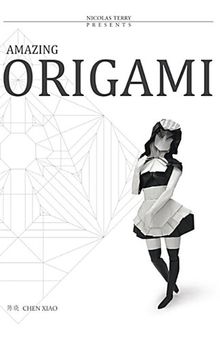دانلود کتاب Amazing Origami
by Chen Xiao, Nicolas Terry|
|
عنوان فارسی: اوریگامی شگفت انگیز |
 دانلود کتاب
دانلود کتاب
 جزییات کتاب
جزییات کتاب
In the last 15 years, the methods and tools of Origami design have become readily accessible to everyone. New designs and designers spring forth like mushrooms after the rain. Many new books are published every year, all over the world.
In the keen eye of the seasoned folder, Chen Xiao stands out well above the crowd.
From the first time I saw pictures of his origami art on the internet, his complex character compositions radiated the look of world class origami just as much as any of his misleadingly simple looking dolls.
The appeal of the figures is such that you immediately want to fold them somehow. I for one remember folding some of his works using crease patterns and being inspired by the rational yet graceful constructions; the same two things I seek in my own works.
Now we have his book, and the appeal of those pictures and the beauty of the structures are met with clear diagrams and enjoyable folding sequences.
He has selected pieces with a gradual crescendo of difficulty and complexity. The variety of his subject matter stretches from animals to human characters.
The designs are composed extremely well and convey very clearly the intellectual process that led to each creation. Take for example how the Husky is made from a simple fish base with the rear legs being obtained from one of the long flaps; a designers. Ultimately however, the end result is perfectly proportioned. The next model is the Rhino, using the same base and idea, and again, the proportions are flawless.
In the beautifully attractive "Little Girl" series, characters are formed with geometric shapes and straight lines, making them look simple on the outside, while the internal structure is a labored jigsaw puzzle of interlocking layers. The result is a gratifying contrast between perception and reality.
After the dolls, Chen Xiao presents us with extremely complex models depicting female human characters. Just like in the simpler pieces, the author uses classic origami proportions, with kite and fish base folds to give the first structural creases. This makes his designs highly folder-friendly. It is easy to feel the delightful conflict of the simple proportions used for such sophisticated figures.
If we analyze now the finished Succubus for example, there is yet another opposition. The round and creamy female forms (somehow achieved on folded paper!) contrast sharply with the leathery wings and the razor sharp devil tail.
Is this not the ultimate concept of a Succubus?
Is this not what it takes to make art?








 این کتاب رو مطالعه کردید؟ نظر شما چیست؟
این کتاب رو مطالعه کردید؟ نظر شما چیست؟
